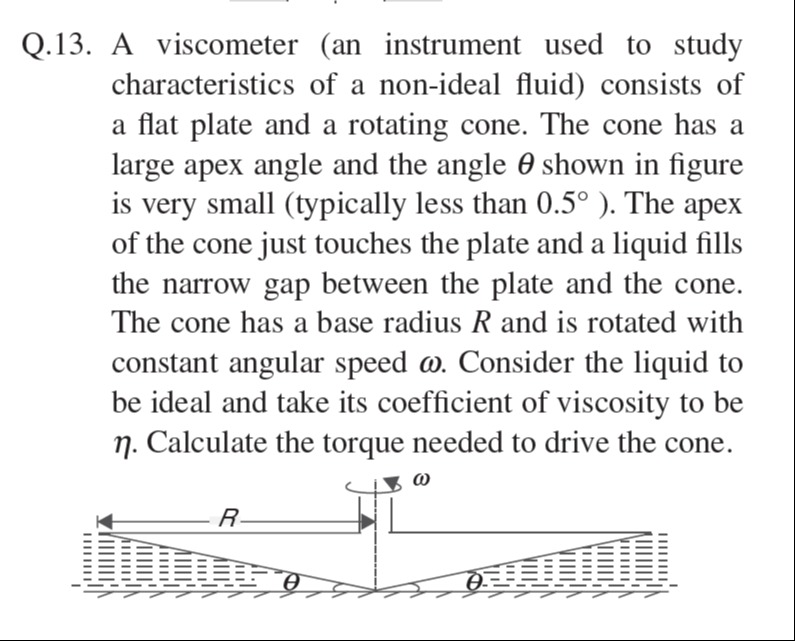Question
Question: A viscometer (an instrument used to study characteristics of a non-ideal fluid) consists of a flat p...
A viscometer (an instrument used to study characteristics of a non-ideal fluid) consists of a flat plate and a rotating cone. The cone has a large apex angle and the angle θ shown in figure is very small (typically less than 0.5° ). The apex of the cone just touches the plate and a liquid fills the narrow gap between the plate and the cone. The cone has a base radius R and is rotated with constant angular speed ω. Consider the liquid to be ideal and take its coefficient of viscosity to be η. Calculate the torque needed to drive the cone.

3θ2πηωR3
Solution
To calculate the torque needed to drive the cone, we use the principles of viscous fluid flow.
-
Identify the geometry and fluid properties:
- The liquid fills the narrow gap between a rotating cone and a stationary flat plate.
- The cone has a base radius R and rotates with constant angular speed ω.
- The angle between the cone and the plate is θ, which is very small.
- The liquid has a coefficient of viscosity η. (Note: The problem statement's "ideal fluid" contradicts "coefficient of viscosity η". We assume it means a viscous fluid with viscosity η.)
-
Determine the gap height: Consider a small annular element at a radial distance r from the axis of rotation. The height of the gap, h, at this radius r is given by h=rtanθ. Since θ is very small (typically less than 0.5°), we can approximate tanθ≈θ (in radians). So, h=rθ.
-
Calculate the velocity gradient: The flat plate is stationary, so the fluid layer at the bottom has a velocity of 0. The cone rotates, so the fluid layer adhering to the cone surface at radius r has a tangential velocity v=rω. Assuming a linear velocity profile across the narrow gap (which is a valid approximation for small θ), the velocity gradient dydv is: dydv=change in heightchange in velocity=hrω−0=rθrω=θω Notice that the velocity gradient θω is constant throughout the fluid gap, independent of r.
-
Calculate the shear stress: According to Newton's law of viscosity, the shear stress τs is given by: τs=ηdydv=ηθω Since dydv is constant, the shear stress τs is also constant over the entire surface of the cone in contact with the fluid.
-
Calculate the torque on an elemental ring: Consider an annular element of radius r and infinitesimal thickness dr. The area of this element is dA=2πrdr. The viscous force dF acting on this elemental area is: dF=τs⋅dA=(ηθω)(2πrdr) The torque dτ exerted by this force about the axis of rotation is r⋅dF: dτ=r⋅dF=r(ηθω)(2πrdr)=θ2πηωr2dr
-
Calculate the total torque: To find the total torque τ needed to drive the cone, integrate dτ from r=0 to r=R: τ=∫0Rθ2πηωr2dr τ=θ2πηω∫0Rr2dr τ=θ2πηω[3r3]0R τ=θ2πηω(3R3−0) τ=3θ2πηωR3
The torque needed to drive the cone is 3θ2πηωR3.
